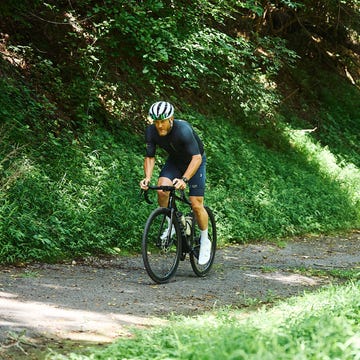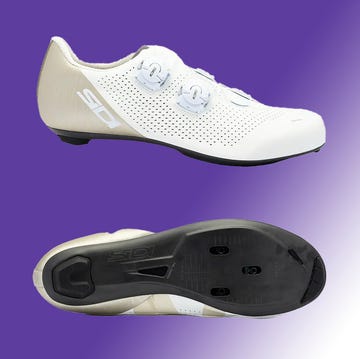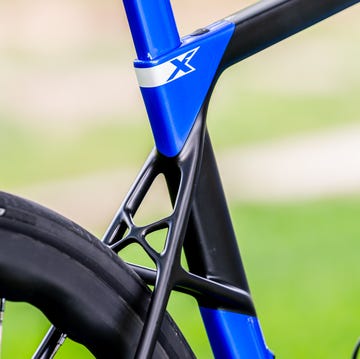The Takeaway: Improving upon the awesome CAAD12 was no easy task, but Cannondale did it.
- Shares geometry and features with Cannondale’s SuperSix Evo.
- Aero tweaks save a few watts.
- Hidden fender mounts for protection during the wet seasons.
Price: $2,100
Weight: 19.8 lb. (54cm)
Buy Now View Gallery
If anyone’s going to make a kick ass aluminum bike, it’s Cannondale. In the early 1980s Cannondale—and Gary Klein—developed oversized aluminum frames which were a radical leap forward in weight and stiffness compared to the steel frames of the day. These early oversized aluminum frames were the first salvo in the materials wars that eventually led to today’s amazing carbon composite frames.
And while Cannondale’s top-of-the-line road frames today are carbon, the brand has continued a connection to aluminum. For many years, Cannondale’s CAAD aluminum bikes have been a benchmark of value and performance.
So it’s a big deal when Cannondale rolls out a new version of this benchmark bike. The new CAAD13 is more aerodynamic and smoother than the CAAD12 it replaces, Cannondale claims, with improved versatility from 30mm tire clearance (on disc models), and hidden fender mounts. The 13 shares geometry and profile with the new SuperSix Evo race bike; this bike is designed to move like a race bike, not a pillowy endurance bike.
My expectations were high, and the CAAD13 easily met them. It’s smoother than the CAAD12, especially over bigger bumps, but none of the fire is damped. This bike is crisp, stiff, lively, and quick. It’s more comfortable on longer rides, but still a perfect pick for mixing it up in an hour long crit. Steering is light and precise, and the Shimano 105 build on this bike offered top-of-the-line shifting and braking performance.
At $2,100 this bike offers more performance and personality many bikes, even ones that cost many times more. It’s a bike you can buy now and will serve you well for a long time. It’s worth upgrading—if that’s your thing—but it doesn’t need a thing. This bike kicks ass.
What’s New
This is a complete redesign of Cannondale’s iconic aluminum road bike. The outgoing CAAD12 is an excellent bike, beloved for offering crisp performance, and a lively ride at an accessible price. It’s a bike that demonstrates that aluminum can hold its own against carbon. So expectations are very high for its replacement. Cannondale claims the 13 is more aerodynamic, as well as more comfortable, and more capable than the model it replaces. If true, Cannondale’s product team has improved upon one of the best bikes, and best values, available—no easy feat.
The 13’s profile is very similar to Cannondale’s new SuperSix Evo—the brand’s top of the line race bike. Like the new SuperSix, the CAAD13 uses truncated airfoil-shaped tubes which have the stiffness and weight of a round tube but are up to 30-percent more aerodynamic. To unlock even more aerodynamic gain, riders can use one water bottle on the optional lowered cage position on the downtube
Frame: aluminum
Fork: carbon
Tire clearance: 30mm
Drivetrain: Shimano 105 11 speed, mechanical
Wheels: Cannondale RD 2.0 rims w/Formula hubs
Crank: Cannondale 1
Chainrings: 52/36
Cassette: Shimano 105, 11-30
Brakes and Rotors: Shimano 105 hydraulic disc, 160mm front, 160mm rear
Tires: Vittoria Rubino Pro w/reflective sidewalls, 28mm
Handlebar: Cannondale 3 compact, aluminum
Seatpost: Cannondale HollowGram 27 KNØT, aluminum
Dropped seatstay attachment and integrated seatpost clamp placed low in the frame—increasing the available bending length of the seatpost—improve compliance, Cannondale claims. The D-shaped seatpost is shared with the SuperSix Evo; complete bikes come with setback posts, but a zero-offset is offered if your fit requires a forward position. Riders can smooth the ride further by fitting 30mm tires on disc models—rim-brake models fit up to 28mm tires.
Geometry is also shared with the new SuperSix Evo, which makes this a bike with tight dimensions and race-influenced handling. With medium-short head tubes, limber riders can set a fairly low position on the CAAD13. However, complete bikes come with a 25mm-tall headset top cap that helps less flexible riders achieve a more sensible position. Sizes 44 through 54 have slacker head tubes and increased offset (55mm) fork than larger sizes. This combination pushes the front wheel forward on smaller sizes to minimize toe-overlap, but also shortens in the bike’s trail dimension to keep handling sporty.
The CAAD13, like the new SuperSix Evo, uses a swappable hatch in the downtube for compatibility with mechanical, electronic, and wireless drivetrains, and Mavic’s Speed Release thru-axle system. When the rains come, the rider can take advantage of the CAAD13’s hidden fender mounts.
The CAAD13 Family
In North America, Cannondale offers the CAAD 13 in five models—two with rim brakes, three with disc brakes—priced from $1,800 to $5,750.
Two of the five models—a $1,800 rim-brake bike and the $2,100 disc-brake bike, both with Shimano 105—are women’s editions. These models do not have different geometry, but are sold in fewer sizes (44, 48, 51, 54cm), different color, and have a women’s saddle.
The remaining models are sold in sizes 44, 48, 51, 54, 56, 58, 60, and 62cm. All models use the same frame and carbon fork.
The line kicks off with the $1,800 105 rim brake model, named after its Shimano 105 drivetrain and brakes. The next model up—the $2,100 Disc 105—has many of the same parts, but switches to disc brakes.
Next is the CAAD13 Ultegra for $2,400. This is a rim brake model with low profile rims for riders who like to keep things more traditional.
The line then makes a big jump to its final model: the $5,750 CAAD13 Disc Force. This bike gets SRAM’s wireless Force eTap AXS group with disc brakes, 45mm-deep carbon rims, and a carbon handlebar and seatpost.
Ride Impressions
Full disclosure: I’m a fan of aluminum road bikes. I own a Vynl and a Stoemper Darrell, and I love the Specialized Allez Sprint DSW. I like that aluminum bikes have a grittier ride than a carbon bike, and I like their punchy liveliness and toughness. For pure performance nothing beats carbon, especially if price is not a concern. But I ride for the love of riding and hardly ever wear a number, so I’ll chose a bike that makes me smile over a bike that makes me faster. And that’s often an aluminum bike.
An aluminum bike like this CAAD13.
Cannondale had a big job trying to improve upon the excellent CAAD 12, and I think they’ve done it. They’ve kept the best of the CAAD 12—its crisp and lively feel—but the ride is more refined. It’s smoother and more comfortable than the 12 without damping out the perky buzz that makes this bike entertainingly communicative. The improved ride is particularly noticeable on bigger bumps which spike through the frame with less energy than they do on the 12.
I’m particularly impressed by the ride because I sampled the Disc 105 bike. When they use carbon, frame engineers can eliminate the dead harshness that permeated first-generation disc-brake frames. The latest carbon disc frames ride as least as well, if not better, than a rim-brake frame. It’s not the same with metal frames: some ride well, but many others are over stiff and dead feeling. The CAAD 13 is one of the good ones. It feels sporty and quick, smooth and lively—just like a good high-performance bike should.
I sampled a 54cm, which is one of the models with slacker head tube angle and greater fork offset. I didn’t know this until I checked the geometry table after I had many hours on the bike. I didn’t know it because I didn’t sense anything different about this bike’s handling compared to its competition, which typically use shorter offset forks and steeper head angles. It handles like most race-inspired road bikes my size, and the steering is light and direct, and accurate at a wide range of speeds. I’ve never been bothered by toe overlap—all my road bikes have it, and it’s not a factor at riding speeds—but if it bothers you, this bike may offer some relief.
The Shimano 105 group on this bike is a gem. I have lots of time on Shimano’s Ultegra and Dura Ace, and 105 performs almost the same, with just a slight reduction in crispness at the levers. My one complaint: the levers buzzed and knocked on bumps. That aside, the disc brakes are smooth and very powerful, the shifting fluid and precise—this is top-of-the-line performance at a value price. The rest of the parts worked well also, and I particularly liked the stealth reflective sidewalls on the tires.
Cannondale’s CAAD series has long been some of the best value-priced and high-performance bikes available. The new CAAD13 is continues that tradition. This is a lively and entertaining bike that’s fast and sharp as well as comfortable and versatile.

A gear editor for his entire career, Matt’s journey to becoming a leading cycling tech journalist started in 1995, and he’s been at it ever since; likely riding more cycling equipment than anyone on the planet along the way. Previous to his time with Bicycling, Matt worked in bike shops as a service manager, mechanic, and sales person. Based in Durango, Colorado, he enjoys riding and testing any and all kinds of bikes, so you’re just as likely to see him on a road bike dressed in Lycra at a Tuesday night worlds ride as you are to find him dressed in a full face helmet and pads riding a bike park on an enduro bike. He doesn’t race often, but he’s game for anything; having entered road races, criteriums, trials competitions, dual slalom, downhill races, enduros, stage races, short track, time trials, and gran fondos. Next up on his to-do list: a multi day bikepacking trip, and an e-bike race.

























